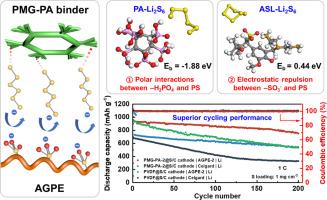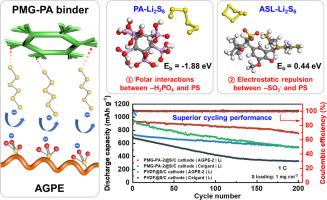离子选择性凝胶聚合物电解质和正极粘合剂源自共用聚醚,可协同缓解锂硫电池中的多硫化物穿梭现象
IF 18.9
1区 材料科学
Q1 CHEMISTRY, PHYSICAL
引用次数: 0
摘要
锂硫(Li-S)电池作为下一代电池最有前途的候选材料之一,具有很高的理论能量密度,但仍然面临着多硫化物(PS)的严重穿梭效应和易燃液态电解质带来的安全问题。为了克服上述挑战,我们提出了一种增强离子选择性的策略,通过将含有环氧基团的聚醚分别与带负电荷的胺化木质素磺酸钠(ASL)和极性植酸(PA)协同交联,制备出用于锂-S电池的PS排斥凝胶聚合物电解质(AGPE)和PS锚定阴极粘结剂(PMG-PA)。与使用聚偏二氟乙烯作为阴极粘合剂的传统液态电解质电池循环性能较差(200 次循环为 329.1 mAh g-1,每次循环容量衰减 0.26%)相比,PS 的协同抑制穿梭效应使得锂-S 电池在 1 C 下循环 200 次可输出 749.7 mAh g-1 的高容量,且每次循环容量衰减 0.11% 的超低容量。此外,AGPE 可将液态电解质限制在聚合物网络中,而 ASL 可在潜在点火事件中熄灭自由基,从而显著提高电池在运行期间的安全性。因此,离子选择性 AGPE 和源自共用聚醚的 PMG-PA 阴极粘合剂的协同设计策略为减轻多硫化物穿梭提供了一种新方法,可用于制造安全可靠的锂-S 电池。本文章由计算机程序翻译,如有差异,请以英文原文为准。


Ion-selective gel polymer electrolyte and cathode binder derived from a shared polyether to synergistically mitigate polysulfides shuttling in lithium sulfur batteries
As one kind of the most promising candidates for next-generation batteries, lithium-sulfur (Li-S) batteries with high theoretical energy density are still faced with the severe shuttle effect of polysulfides (PS) and safety issues caused by the flammable liquid electrolytes. To overcome the above challenges, an enhanced ion-selective strategy is proposed by collaboratively crosslinking a polyether containing epoxy groups with negatively charged aminated sodium lignosulfonate (ASL) and polar phytic acid (PA), respectively, to prepare a PS-repelling gel polymer electrolyte (AGPE) and a PS-anchoring cathode binder (PMG-PA) for Li-S batteries. The synergistically suppressed shuttle effect of PS makes the Li-S battery deliver a high capacity of 749.7 mAh g-1 over 200 cycles at 1 C with a super low capacity decay of 0.11 % per cycle, compared to the poor cycling performance (329.1 mAh g-1 over 200 cycles with a capacity decay of 0.26 % per cycle) of the conventional liquid electrolyte-based battery using polyvinylidene difluoride as the cathode binder. Furthermore, AGPE confines the liquid electrolyte within the polymer network, while ASL quenches free radicals during potential ignition events, thereby significantly enhancing the battery safety during operation. Therefore, the co-design strategy of ion-selective AGPE and PMG-PA cathode binder derived from a shared polyether offers a new way to mitigate polysulfides shuttling for safe and reliable Li-S batteries.
求助全文
通过发布文献求助,成功后即可免费获取论文全文。
去求助
来源期刊

Energy Storage Materials
Materials Science-General Materials Science
CiteScore
33.00
自引率
5.90%
发文量
652
审稿时长
27 days
期刊介绍:
Energy Storage Materials is a global interdisciplinary journal dedicated to sharing scientific and technological advancements in materials and devices for advanced energy storage and related energy conversion, such as in metal-O2 batteries. The journal features comprehensive research articles, including full papers and short communications, as well as authoritative feature articles and reviews by leading experts in the field.
Energy Storage Materials covers a wide range of topics, including the synthesis, fabrication, structure, properties, performance, and technological applications of energy storage materials. Additionally, the journal explores strategies, policies, and developments in the field of energy storage materials and devices for sustainable energy.
Published papers are selected based on their scientific and technological significance, their ability to provide valuable new knowledge, and their relevance to the international research community.
 求助内容:
求助内容: 应助结果提醒方式:
应助结果提醒方式:


